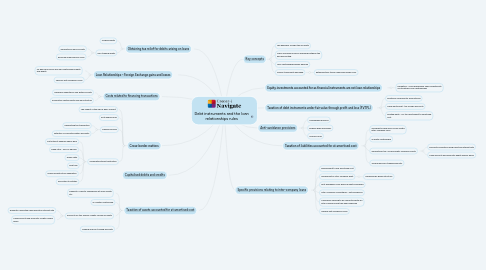Debt instruments and the loan relationships rules
by Martin Jackson


1. [Capitalised debits and credits](https://library.croneri.co.uk/po-heading-id_mFNUKItTlEOck03883k3Jw)
2. [Costs related to financing transactions](https://library.croneri.co.uk/po-heading-id_PcTF6QbuWE6FLFyN749gKg)
2.1. Generally deducted in line with accounts
2.2. Acquisition related costs may be restricted
3. [Loan Relationships – Foreign Exchange gains and losses](https://library.croneri.co.uk/po-heading-id_sao3EOuhckmTTxw9zbB-zg#po-heading-id__ZA9TaEEBk2L5cEeH7pIzw)
3.1. FX gains and losses are loan relationship credits and debits
3.2. Specific anti-avoidance rules
4. [Obtaining tax relief for debits arising on loans](https://library.croneri.co.uk/po-heading-id_sao3EOuhckmTTxw9zbB-zg#po-heading-id_bvz7QLaNIUSYF-CeFda8KA)
4.1. Trading debits
4.2. Non-trading debits
4.2.1. Amounts are per accounts
4.2.2. Relieved under specific rules
5. [Taxation of assets accounted for at amortised cost](https://library.croneri.co.uk/po-heading-id_xXW9NNcPb0u4XROgfFXS-A)
5.1. Deposits, Loans to subsidiaries at arms-length etc
5.2. A creditor relationship
5.3. Amounts for tax, usually credits, follow accounts
5.3.1. Amounts computed using effective interest rate
5.3.2. Cash amounts and accounts credits usually differ
5.4. Trading and non-trading amounts
6. [Equity investments accounted for as financial instruments are not loan relationships](https://library.croneri.co.uk/po-heading-id_Q9LHstfA9EyCBuzXZVX11g)
6.1. Exception - some preference share investments are treated as loan relationships
7. [Anti-avoidance provisions](https://library.croneri.co.uk/po-heading-id_zkRHHOztL0m7og1pW_IDZw)
7.1. Unallowable purpose
7.2. Regime wide provisions
7.3. Specific rules
8. [Specific provisions relating to inter-company loans](https://library.croneri.co.uk/po-heading-id_NWuN2hhMp0qsCuQpmSp0Nw)
8.1. Requirement to use amortised cost
8.2. Impairment of inter-company debt
8.2.1. Simplifying a group structure
8.3. Anti-avoidance rules where a debt is impaired
8.4. Inter-company convertibles – anti-avoidance
8.5. Companies ceasing to be connected after an inter-company debt has been impaired
8.6. General anti-avoidance rules
9. [Taxation of debt instruments under fair value through profit and loss (FVTPL)](https://library.croneri.co.uk/po-heading-id_HD9_Sw7IskGClh2kB0IhiQ)
9.1. Relatively infrequently encountered
9.2. Third-party debt - tax follows accounts
9.3. Related party - for tax must adjust to amortised cost
10. [Key concepts](https://library.croneri.co.uk/po-heading-id_QCSXdr8XpEmOOaxK1NvHYw)
10.1. Tax generally follows the accounts
10.2. There are differences in approach between tax and accounting
10.3. Loan relationships widely defined
10.4. Simple trade debts excluded
10.4.1. Extended time to pay may bring inside rules
11. [Taxation of liabilities accounted for at amortised cost](https://library.croneri.co.uk/po-heading-id_tMu9gq7jSEmgU5F14ovYrQ)
11.1. Overdrafts, bank loans, arms-length inter-company loans
11.2. A debtor relationship
11.3. Amounts for tax, usually debits, follow accounts
11.3.1. Amounts computed using effective interest rate
11.3.2. Cash amounts and accounts debits usually differ
11.4. Trading and non-trading amounts
12. [Cross-border matters](https://library.croneri.co.uk/po-heading-id_D_NO9qGhlkOXLsMTxXjrng)
12.1. The impact of the OECD BEPS Project
12.2. Anti-hybrid rules
12.3. Transfer pricing
12.3.1. Delineating the transaction
12.3.2. Potential re-characterisation as equity
12.4. Corporate interest restriction
12.4.1. Net interest expense above £2m
12.4.2. Fixed ratio - 30% of EBITDA
12.4.3. Group ratio
12.4.4. Debt cap
12.4.5. Public infrastructure exemption
12.4.6. Allocation to entities
